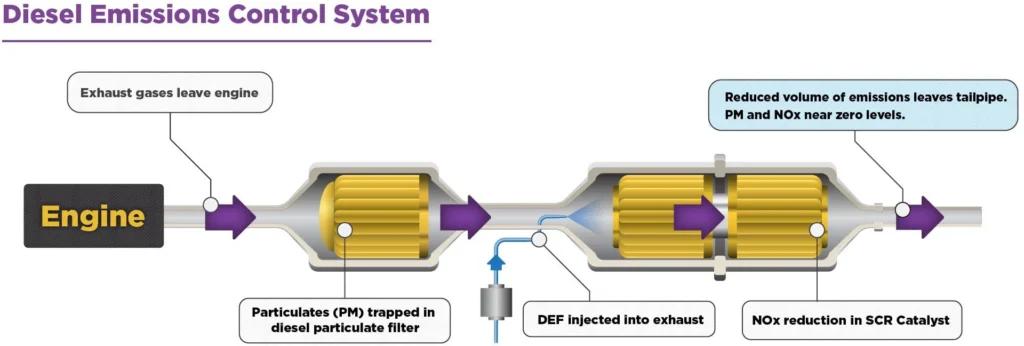In simple terms, the SCR system in cars is like a “tailpipe purifier” for diesel vehicles.
Its main task is to deal with a harmful gas in diesel engine exhaust – nitrogen oxides (NOx) – and turn them into harmless substances before they are emitted, making cars more environmentally friendly.
1. What is SCR?
- SCR stands for Selective Catalytic Reduction.
- It is a mandatory exhaust after-treatment technology for modern diesel vehicles (especially trucks, buses, and some passenger cars) to meet strict emission regulations.
2. Why do we need SCR?
- Diesel engines produce a lot of nitrogen oxides (NOx) during operation, which are harmful to air quality and human health.
- It is difficult to reduce NOx significantly by improving the engine itself, so an SCR system, a kind of “purification workshop“, is needed to handle it in the exhaust pipe.

3. How does the SCR system work?
Imagine spraying “medicine” into the exhaust to detoxify it:
- Spray “medicine” (urea solution): In the exhaust pipe, a special device accurately sprays a liquid called “vehicle urea” (also known as AdBlue or diesel exhaust treatment fluid) into the high-temperature diesel exhaust.
- “Medicine” turns into “detoxifying agent” (ammonia): At high temperatures, the sprayed urea solution quickly decomposes, producing a gas called ammonia (NH3).
- “Detoxification” reaction (turning into harmless substances): These ammonia gases then flow through a device filled with a special catalyst (like a honeycomb-shaped filter). On the surface of this catalyst, ammonia (NH3) selectively captures harmful nitrogen oxides (NOx) in the exhaust and converts them into two completely harmless substances: nitrogen (N2) and water vapor (H2O), which are then released into the atmosphere.
4. What are the benefits of using SCR?
- Extremely environmentally friendly: This is the primary purpose! It can significantly reduce NOx pollution from diesel vehicles, protecting our blue sky and white clouds.
- Potential fuel savings: Compared to other emission reduction technologies (such as EGR + DPF), the impact of the SCR system on engine fuel consumption is relatively small, and in some cases, even a slight improvement in fuel efficiency can be achieved due to optimized combustion.
- No compromise on power: It can effectively reduce emissions while not sacrificing the power performance of the engine.
5. What should car owners pay attention to?
- Need to add “urea”: The SCR system requires vehicle urea solution to function. Just like cars need gasoline, you need to regularly check and refill the specialized urea solution. Generally speaking, consuming 100 liters of diesel requires about 5 liters of urea solution.
- Pay attention to the “SCR light”: If there is a SCR indicator light (yellow or red) on your car’s dashboard, it means that the system may have a problem, such as low urea level, clogged injection system, sensor fault, etc.
- Address faults promptly: Never ignore the SCR light! If it lights up and is not addressed in time, the vehicle computer may automatically limit the engine power (the car loses power), and in severe cases, it may cause damage to the urea pump and other components, resulting in higher repair costs.
- Use high-quality urea: Always use standardized vehicle urea. Low-quality urea can damage expensive catalysts.
- Regular maintenance: Although the SCR system itself is quite reliable, core components such as catalysts also have a service life and need to be maintained or replaced according to the manufacturer’s recommendations.
Summery
SCR is:
The SCR (Selective Catalytic Reduction) System is an essential exhaust after-treatment technology for diesel vehicles, specifically designed to treat nitrogen oxides (NOₓ).
Necessity of the System
Diesel engines produce a large amount of nitrogen oxides during operation. Relying solely on engine improvements is insufficient to achieve significant emission reductions—hence the need for the SCR System to handle this issue.
Working Principle
Automotive urea is injected into the exhaust pipe. At high temperatures, the urea decomposes to release ammonia (NH₃), which then reacts with nitrogen oxides via a catalyst to convert them into harmless substances.

